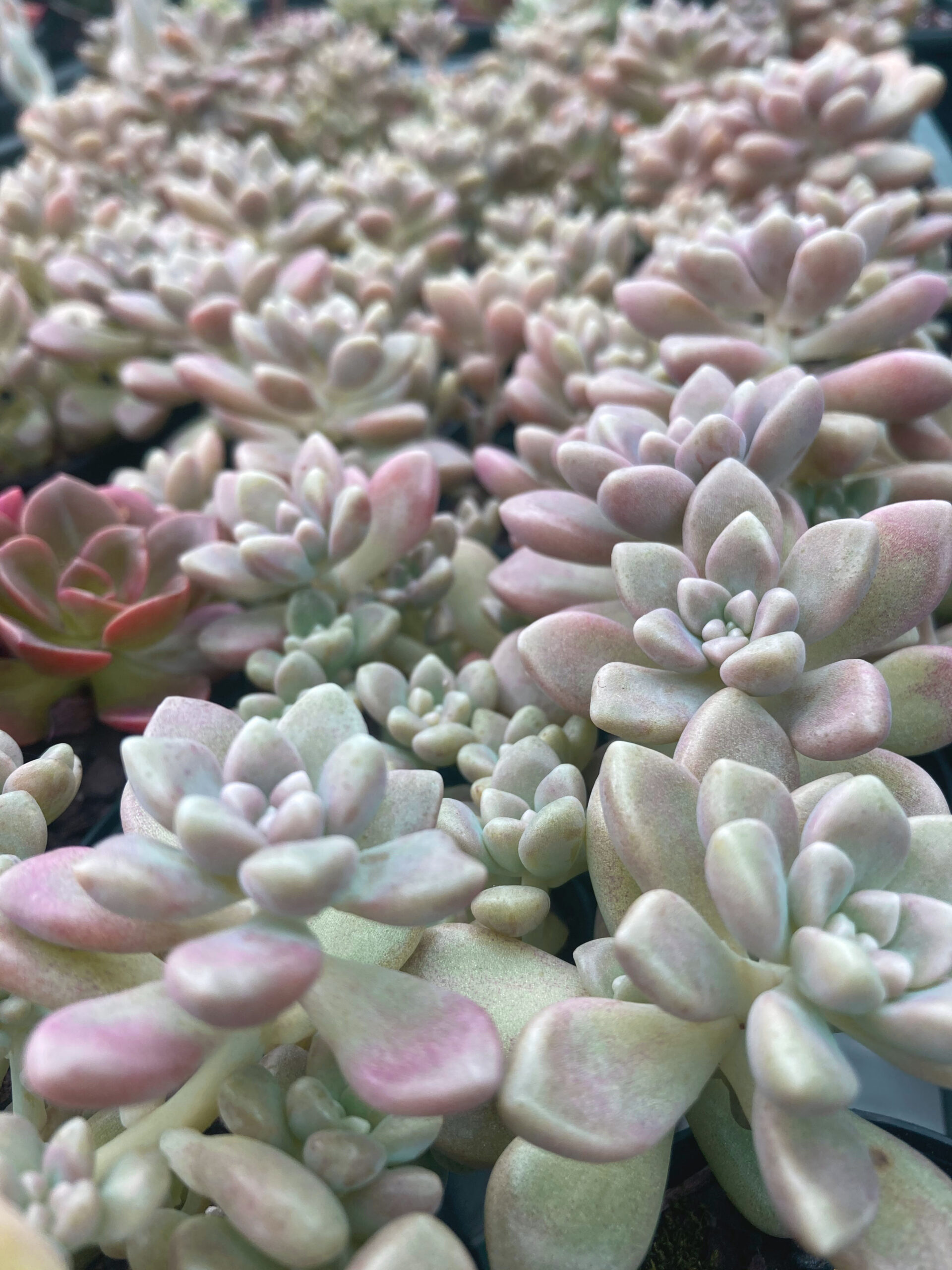Your cart is currently empty!

Graptopetalum Mendozae Care & Propagation
If, like me, you have a thing for cute pink and hardy succulents then you need Graptopetalum mendozae in your life. This succulent is native to Mexico but can now be found in many succulent collections around the world.
In this article we’ll have a look at all things Graptopetalum mendozae. You can also watch the video below.
Graptopetalum mendozae forms low-growing shrubby clusters of small pink rosettes. Individual rosettes are only tiny and reach about 4cm/ 1.6″ in diameter but they offset freely and new branches grow abundantly.
Mendozae can reach approximately 10cm in height though the branches tend to fall and trail. Clusters can pretty much grow indefinitely if there’s enough room to spread. When the stalks touch the ground they will send roots of their own independently of the main stem. This is what allows a potentially huge spread.
The colour, as with many other succulents, will change throughout the year based on the seasons, temperature, sun exposure and general growing environment.
The colour palette can range from light pink, green-pink to deeper shades of pink. The brightest colors usually come through in the cold season.
The leaves are small, chubby and pointy at the end with a very light dusting of farina. The farina protects succulents from the suns UV and acts like a sunscreen. Because there is so little farina, the leaves are more shiny and almost sparkly when held up to the sun.
When mendozae is a little stressed it will have smaller, stubbier leaves.
Care
Graptopetalum mendozae is a sun lover and will grow best when exposed to at least 4 hours of sunlight. Having said that, it is a very versatile plant that will tolerate full, bright shade when grown outside but, it’s more likely to grow pale, with spread out and delicate leaves.
When the sun is lacking, this succulent will also be more prone to fungal disease such as powdery mildew and rot.
Although, mendozae can live in shade outdoors it is not suitable to be grown indoors long terms as it’s simply not bright enough in the average house. It can last a few months but is likely to eventually perish.
In frost-free climates this plant can be grown outdoors all year round and is suitable for pots as well as the garden.
In the garden make sure to plant where water doesn’t pool after the rain. Slope or raised beds are best.
Graptopetalum mendoza will grow in most potting mix types but, if you want nice looking pot plants, good quality succulent potting mix will ensure your plants have the right pH and nutrients.
I would highly recommend breaking up the soil and adding in any potting mix when planting in the garden. This succulent has very thin roots and, by cultivating the garden dirt, you’ll make it easier for them to spread which will help the plant grow better.
Overwatering and rain are not an issue, in my experience, as long as pot plants are in well draining potting mix and there’s a drainage hole.
During dry spells or, if grown undercover, water when the potting mix has dried up from previous watering. This succulent is drought tolerant and will be okay even on minimal water but to avoid leaf loss and hydrophobic potting mix it’s best to water regularly.
Mendozae can live through some serious heatwaves and has survived 45C/113F here at the nursery but, moving these plants into shade or under shade cloth when heatwaves are expected is advised to avoid sunburn.
Frost can be an issue as Graptopetalum mendozae is not frost hardy. In climates with cold winters, this succulent should be brought indoors for the duration of the frosts. Our nursery mendozae grows outdoors all year round and it can tolerate occasional mild frost but, once it settles the frost can leave dark marks and even kill the plant.
Propagation
Graptopetalum mendozae will often propagate itself and is super easy to grow from leaves and cuttings. Seed propagation is also possible but, it’s in my opinion pointless, as it will take quite some time for the seedlings to reach any meaningful size.
If you want to make lots of plants leaf propagation is the way to go. The success rate is over 90% and the leaves are very easy to take off.
For more instant results, try propagating cuttings. Multi-head branches as well as individual rosettes will grow well.
After separating, leave the cuttings to dry for at least 24 hours so the wound has time to heal. This will prevent disease and bacteria getting in.
Whichever propagation method you use wait until the growing season comes around. I find the best time to propagate leaves is spring. Cuttings will root in spring, summer and early autumn. Do be careful during summer heat waves as the mendozae struggle to propagate when very hot and cuttings, as well as leaves, can die easily in hot direct sun.
Once the cuttings have dried up you can plant them in pots or trays filled with good quality succulent potting mix.
Pests
Graptopetalum mendozae is on the menu of many succulent pests. When growing this plant you are very likely to encounter aphids at flowering time, mealy bugs, slugs, snails, caterpillars and grasshoppers.
Regular pest check and management is a must with this succulent, otherwise used as a trap plant around more valuable plants. Most pests will attack the mendozae before they touch any other plants.
Toxicity
Graptopetalum mendozae is not toxic to cats, dogs other animals or humans and is safe to have around kids. Despite this I would not recommend eating this succulent
Where Can I Get It
Graptopetalum mendozae should be quite easy to purchase online and is likely to be stocked in succulent nurseries.
My own nursery Fern Farm Plants sells this succulent online as a small plant.